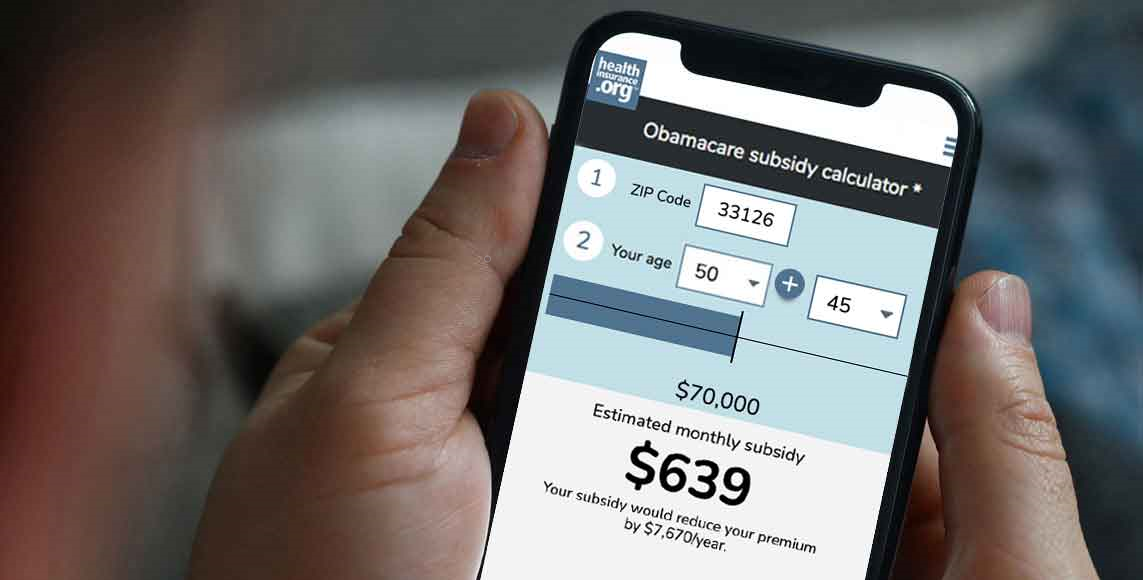
In this article
- What was the ACA’s ‘family glitch?’
- Biden administration rule change fixed the family glitch
- Who was affected by the ‘family glitch?’
- The ‘glitch’ and employer-sponsored plans
- How was the family glitch created?
- Previous (failed) legislative efforts to fix the ‘family glitch’
- How does fixing the ‘family glitch’ help families?
Most employers that offer health insurance tend to be quite generous when it comes to subsidizing the cost of their employees’ premiums. And although many also pay a large portion of the cost to add dependents to the plan, it’s not uncommon to see a plan that requires significant employee contributions to cover dependents. The IRS notes that 12% of workers pay more than $10,000/year in premiums for employer-sponsored family health coverage.
From 2014 through 2022, these families were generally ineligible for financial assistance if they wanted to purchase their own health coverage instead, through the exchange/marketplace. But that changed as of 2023. The IRS finalized a new regulation to replace a 2013 IRS regulation that created the “family glitch.” Under the new rules, some families became newly eligible for marketplace premium subsidies as of 2023.
What is the ACA's 'family glitch?'
The “family glitch” refers to the fact that from 2014 through 2022, when the affordability of an employer-sponsored health plan was determined, it was based on just the cost for the employee. The cost to add family members was not taken into consideration. But the affordability determination was then applied to all members of the family who could be added to the employer-sponsored health plan.
A person is only eligible for premium subsidies in the exchange if they are not eligible for affordable employer-sponsored health insurance. So if a family’s employer-sponsored coverage offer was considered “affordable” (based on the cost to cover just the employee) and provided minimum value, the entire family was ineligible for subsidies in the exchange.
It didn’t matter how much the employee would have had to pay to purchase family coverage. The family members were not eligible for exchange subsidies if the employee could get employer-sponsored coverage just for him or herself, for less than 9.61% of the household’s income in 2022 (this threshold is indexed annually; it’s 9.12% in 2023). As long as the employee’s portion of the premium is affordable, the cost for the family could have ended up being 25% — or more — of their household income and they still had no access to premium subsidies. They could either pay full price in the individual market, or pay whatever the employer required to cover the family on the employer’s plan, despite both options being financially unrealistic.
(In 2023, employer-sponsored coverage is deemed “affordable” if it costs less than 9.12% of household income. The Build Back Better Act called for the affordability threshold to be reset to 8.5% of household income, but that legislation stalled in the Senate after passing the House in November 2021. Although some parts of the Build Back Better Act were ultimately included in the Inflation Reduction Act that was enacted in August 2022, this provision was not among them.)
Employer Health Plan Affordability Calculator
Biden administration rule change fixes the family glitch
Soon after taking office, President Biden issued an executive order to protect and strengthen Medicaid and the ACA. It called for “policies or practices that may reduce the affordability of coverage or financial assistance for coverage, including for dependents,” which hinted that the Biden administration would be open to a regulatory approach to fixing the family glitch.
In the fall of 2021, the Office of Management and Budget (OMB) noted that the Treasury Department and IRS were proposing regulatory changes related to that executive order. As of March 2022, a proposed rule was under review by OMB, and the details of the proposed fix were published in early April.
The IRS finalized the rule change in October 2022, a few weeks before the start of the open enrollment period for 2023 individual/family health coverage.
The rule change is fairly simple and straightforward: Instead of basing the affordability determination for a family’s employer-sponsored health insurance on just the cost to cover the employee, the determination will now be made based on the cost to cover the employee plus family members, if applicable. Here are the important points to understand about this:
- The family glitch fix is in effect as of 2023. So when families applied for 2023 coverage during the open enrollment period in the fall of 2022, the new rules were used to determine whether anyone in the household qualified for a premium subsidy.
- If a family has to pay more than a certain percentage of household income (9.12% in 2023) for the employer-sponsored plan, they will potentially be eligible for premium tax credits in the marketplace. The same would also be true if the coverage offered to the family does not provide minimum value. So if an employer offers, for example, separate coverage to family members that is affordable but that doesn’t provide minimum value, the family members would potentially still be eligible for a subsidy to buy a marketplace plan.
- There is a separate affordability determination for the employee (based on self-only coverage), and for family members (based on the total cost of family coverage). So depending on how an employer subsidizes the cost of family coverage, it’s possible that coverage could be considered affordable for the employee but not for family members. In that case, the family members would potentially be eligible for a premium tax credit in the marketplace, but the employee would not.
- Nothing has changed about the ACA’s employer mandate. Large employers still have to provide affordable, minimum-value coverage to their full-time employees, and offer coverage to those employees’ dependents (offering coverage to spouses is optional). But there continue to be no affordability requirements as far as the coverage that’s offered to dependents. The employer mandate penalty is only triggered if an employee’s coverage is unaffordable and they receive a premium tax credit in the marketplace. There is no mechanism for triggering the penalty based on an employee’s family members receiving premium tax credits in the marketplace.
- If a family has some members on a marketplace plan and others covered under one or more employer-sponsored plans and/or Medicare, the family’s total premium costs could still be somewhat unaffordable. Premium tax credits currently ensure that households don’t have to spend more than 8.5% of household income to buy the benchmark plan, but that’s only applicable to the marketplace premiums. Premiums for other coverage are not factored in, as described here with regards to households with one spouse on Medicare and the other on a marketplace plan. This is discussed in more detail below.
- The cost to cover non-dependent family members is not taken into consideration. So for example, young adults can remain on a parent’s health plan until they turn 26, but are generally not considered a tax dependent for the last few years of that window. So if they enroll in the family plan, the cost to cover them is not counted when the affordability of the family plan is determined. (Young adults in this situation can already apply for premium subsidies in the marketplace based on their own income, and the fact that they have the option to be added to a parent’s employer-sponsored health insurance is not taken into consideration.)
- In the final rule change, the IRS notes that “new take-up of Exchange coverage may be modest relative to the size of the newly eligible population” even with the family glitch fix in place. This is due to a variety of factors, including the way subsidies are determined with respect to household income (described in more detail below), the multiple deductibles and out-of-pocket maximums that a family would have if they keep the employee on an employer-sponsored plan and enroll the rest of the family in a marketplace plan, and the fact that families might want to keep the benefits and provider network offered by the employer, instead of switching to individual market coverage.
- Historically, there have been roughly 5 million people affected by the family glitch. When the rule change was proposed, the White House published a statement indicating that they expected about 200,000 uninsured people to gain coverage as a result of the proposed family glitch fix. And they anticipated that “nearly 1 million Americans would see their coverage become more affordable” under the new rules. (As described below, fixing the family glitch does not result in subsidies for everyone who was caught by the family glitch; some will still find coverage to be unaffordable.) In the final rule, the IRS noted some wide variability in the projections for how this rule will impact enrollment: Somewhere between 600,000 and 2.3 million newly-eligible people are expected to enroll in coverage through the exchange/marketplace, and somewhere between 80,000 and 700,000 uninsured people are expected to gain coverage.
The family glitch relied on minuscule bits of text within the ACA rather than the broad scope and intent of the law. The overarching goal of Obamacare was to expand access to health insurance, and to make it affordable. Yet the 2013 rule (used for coverage effective from 2014 through 2022) on what constitutes “affordable” employer-sponsored coverage did nothing to make health insurance affordable or accessible for low- and moderate-income families whose employers didn’t subsidize a significant portion of dependents’ coverage. The Biden administration’s goal was to change that. The new IRS rule change highlights the fact that the goal of the ACA is to make coverage more accessible and affordable, and that the new rules are necessary in order to make that happen.
How was the family glitch created?
The “family glitch” was clarified by the IRS in a final rule published in early 2013, based on the language of the ACA. There are two main sections of the law that were involved: 36B deals with subsidies, and 5000A deals with the individual mandate and penalty.
In 36B, the law states that an employer plan is affordable as long as the employee’s required contribution doesn’t exceed 9.5% of income (that’s indexed annually; it’s 9.12% in 2023). And to clarify “required contribution” the statute refers us to the definition in 5000A, which states that it’s the amount that must be paid for self-only coverage.
When the IRS issued its rule in 2013, the agency noted that some commenters had suggested that the earlier proposed regulation be modified to define the employee’s contribution as the total amount the employee must pay for family coverage. But ultimately the rule was issued without changing the definition of the employee’s required contribution.
Health Affairs explains that this was not an accident or oversight — it was carefully considered and the final regulation was delayed while the Government Accountability Office and the IRS analyzed the impact of the decision. There were concerns that employers would increase the contributions required to enroll family members, which would push more people off employer plans and into the exchanges, driving up the total cost of subsidies. Ultimately, those concerns prevailed and the “family glitch” was born.
But even at the time, it was clear that there was a lot of ambiguity in terms of how affordability of employer-sponsored plan should be determined. In the proposed fix that was published in 2022 (see page 11), the IRS notes that a Joint Committee on Taxation report in 2010 initially indicated that affordability would be based on the cost for the type of coverage that was applicable to a particular employee (ie, self-only, family, etc.) but that the wording was later changed to indicate that the cost of self-only coverage would be used regardless of the employee’s circumstances.
And in the final rule that the IRS published in 2022, fixing the family glitch, they note that original (2010) projections on the cost of premium tax credits had been too high, based on what proved to be incorrect assumptions about “how the economy would change and how people and employers would respond to the law, and that, to a lesser extent, the differences were caused by judicial decisions, statutory changes, and administrative actions that followed the ACA’s enactment.” In other words, exchange enrollment and premium tax credit costs have been lower than expected.
The ‘glitch’ and employer-sponsored plans
Under the ACA, employers with 50 or more full-time equivalent employees are required to offer coverage to their employees and to their employees’ children, but not to spouses – although it’s still relatively rare for companies to exclude spouses. If an employer plan doesn’t cover spouses at all, the spouse was already eligible to get subsidies in the exchange based on income. There was no “glitch” for the spouse if the employer coverage simply wasn’t available to the spouse.
(But it should be noted that the spouse’s premium subsidy eligibility would still be based on the entire household’s income, which we’ll address in an example in a moment — the short story is that the spouse, applying for coverage on their own, might not end up being eligible for subsidies even with a fairly modest household income.)
If large employers don’t make the coverage affordable for the employee (self-only coverage) and the employee then obtains a subsidy in the exchange, the employer is subject to a penalty. So there is an incentive for employers to make sure that they are subsidizing a good chunk of the employee’s premium.
But while large employers are required to offer health coverage to employees’ children (and most also do so for spouses), there is no requirement that the employer pay for that coverage, because the cost of the dependents’ coverage is not factored into the “affordable” calculation. Many companies go above and beyond, subsidizing a large portion of dependents’ health insurance premiums (in 2022, the average employer paid about 73% of total family premiums). But not all of them do.
And in conjunction with the family glitch fix, the IRS has clarified that employers could allow employees to make a cafeteria plan coverage election change to remove family members from an employer-sponsored plan as of January 2023, so that they could take advantage of newly-available premium subsidies in the marketplace. But it’s important to note that although the final rule on the family glitch fix indicates that “employees will be permitted under the notice to revoke coverage in an employer plan associated with a cafeteria plan beginning in 2023,” Notice 2022-41 actually just permits employers to allow this, but does not require them to do so.
But if your employer adopted the provisions in IRS Notice 2022-41 and the employer’s plan doesn’t follow the calendar year (so you normally would not be able to make a change to your coverage on January 1), you had the option to switch your family members to a plan purchased in the exchange during open enrollment in the fall of 2022, and remove them from your employer’s plan when the exchange plan took effect in January 2023.
Who's affected by the 'family glitch?'
Somewhere between two million and six million people have historically been impacted by the family glitch (a recent KFF analysis estimated that it was 5.1 million). They were disproportionately lower-income, because lower-wage workers have to spend a larger percentage of their income to pay for health insurance if subsidies aren’t available, and because higher-income workers are more likely to work for companies that heavily subsidize coverage for dependents.
Fortunately for many of the families caught by the glitch, the Children’s Health Insurance Program (CHIP) provides coverage for children with household incomes well over 200% of poverty in most states. But the KFF analysis notes that more than half of the people caught by the family glitch were children under the age of 18 who were not eligible for Medicaid or CHIP. So while Medicaid and CHIP provide a good safety net for many families (leaving just the spouse without affordable coverage), that was certainly not the case for all families caught by the family glitch.
Have there been legislative efforts to fix the 'family glitch?'
In 2014, then-Senator Al Franken introduced the Family Coverage Act, which would have adjusted the law so that the affordability test would be applied to the entire premium that a worker must pay for family coverage, not just employee-only coverage. The bill never progressed beyond committees though, and lawmakers seemed hesitant to fix the family glitch, given the additional burden it would place on the taxpayer-funded subsidy program.
Hillary Clinton proposed fixing the family glitch as part of her 2016 presidential campaign, but she lost the election and Congress remained under GOP control after the 2016 elections. Various pieces of legislation have been introduced in Congress in the last few years to fix the family glitch, but none of them have been enacted.
However, the Biden administration has fixed the family glitch via the rulemaking process, as described above. The downside to this approach is that it could be undone by a future administration via another round of rulemaking, without input from Congress.
How does fixing the 'family glitch' help families?
Although the new IRS rules have helped to make coverage more affordable for some families, they don’t help everyone. It’s important to understand that the rule change has resulted in some employees’ family members becoming newly eligible for premium subsidies, but not the employees themselves.
That would mean the family has two different plans: The employer-sponsored coverage for the employee, and exchange/marketplace coverage for the rest of the family (alternatively, the employee could decline the employer’s plan and join the family on the marketplace plan, but without a subsidy).
Since the family glitch fix only makes the spouse and dependents eligible for subsidies, some families won’t see much in the way of relief, because of the way premium subsidies are calculated. As described above, the rule change finalized by the IRS calls for a multi-step approach: Affordability determinations will continue to be made for employee-only coverage, and also for family coverage. If the employee’s coverage is considered affordable, the employee will not be eligible for subsidies in the marketplace, even if the rest of their family is.
This leaves some families with difficult decisions in terms of their coverage options. For example, consider a household in Chicago with two 40-year-old parents and two young children (we’ll use 2022 premium amounts, since they’re available, even though the glitch fix doesn’t take effect until 2023). Let’s say they earn $85,000, so about 306% of the federal poverty level (FPL) for 2023 health coverage (the 2022 FPL numbers are used to determine 2023 subsidy amounts). The kids are CHIP-eligible in Illinois, and we’ll assume that one parent has access to affordable coverage from an employer. But we’ll assume that the family has to pay the full cost of adding the other parent to the employer’s plan, and that it’s not affordable for them to do that.
With the rules changed to allow that spouse to have access to premium subsidies due to the employer-sponsored plan being unaffordable for the spouse (which is what the new IRS regulations allow), they still don’t qualify for a premium subsidy in the exchange, even with the American Rescue Plan’s premium subsidy enhancements. That’s because their expected contribution amount for the benchmark plan is roughly $5,228 (that’s 6.15% of their $85,000 household income). And the benchmark premium, in this case, is only about $4,532 in annual premiums, which is 5.3% of their household income. So the spouse can buy a plan in the exchange, but they aren’t going to get any subsidies.
This would also be the case if the employer just didn’t offer coverage to spouses at all, which has often been proposed as a potential solution to the family glitch. It’s widely assumed that if the spouse isn’t eligible to participate in the employer’s plan and the family’s household income is in the subsidy-eligible range, the spouse would automatically be eligible for subsidies in the exchange. But oftentimes, that’s not going to be the case.
That’s because the exchange is going to be looking at the premium for just the spouse on their own, and comparing it with the applicable percentage of the whole household’s income. Depending on where they live and how old they are, they may not be eligible for a subsidy at all, even if the family’s income is modest. This is similar to what happens when one spouse moves onto Medicare and the other remains on a marketplace plan (which could be called the “Medicare glitch”).
This is in contrast to a situation in which the spouse was a single individual, age 40, earning 306% of the poverty level for a single person — about $41,585 when we’re considering 2023 coverage — and thus eligible for a subsidy of about $164/month. This is most likely what people are picturing when they assume that the spouse would be eligible for a subsidy in this case, but we have to keep in mind that the subsidy is going to be calculated based on the household’s income.
But on the other hand, consider the same scenario but the parents are both 60. Because the spouse’s individual market plan is much more expensive (since they’re 60 instead of 40), the spouse would get a subsidy of about $365/month in 2023 (this is larger than it used to be, due to the American Rescue Plan’s subsidy increases, which will continue to be in effect through at least 2025). This is because the full-price premium for the spouse, on their own, would be well over 6.15% of the household’s income.
And the impact of the family glitch fix will also vary from state to state, since the cost of health coverage varies by area. A recent multi-state analysis by Third Way found that in most states, total premium savings would be significant for a household earning 200% of the poverty level, and much less significant at 300% of the poverty level. And at 400% of the poverty level, none of the scenarios they examined would result in an overall premium savings under the proposed fix.
Clearly, there is no one-size-fits-all solution. As with other aspects of health care reform, it’s complicated.
Louise Norris is an individual health insurance broker who has been writing about health insurance and health reform since 2006. She has written dozens of opinions and educational pieces about the Affordable Care Act for healthinsurance.org.








